 Tags: Creators, Innovators, Disruptive Technologies, World Changers, United Nations, Millenium Project, Agenda 2021, Agenda 2030, Agenda 2050, Income Inequality, Depopulation, Redistributing Wealth, Rich 1%, Poor 99%
Tags: Creators, Innovators, Disruptive Technologies, World Changers, United Nations, Millenium Project, Agenda 2021, Agenda 2030, Agenda 2050, Income Inequality, Depopulation, Redistributing Wealth, Rich 1%, Poor 99%
So, I do not have time to make comments or mark the highlights. But, I am sure you can grasp what is happening in relation to these new OLYMPIC GAMES.
spacer
spacer
Olympic games were invented in 776 BC, in the ancient era when the World was ruled by the strongest and the fastest people.
Today’s world is ruled by different people. It is driven by →innovation and →entrepreneurial creativity and needs new Games.
Internet-powered Innompics Games (Innomopics) are intellectual games for innovators. Innompics are to help modern world changers demonstrate their arts and shine. >>>
spacer
INNOMPIC GAMES launched! Laucnh ceremony 10 September 2016 …
spacer

spacer
INNOMPIC GAMES – intellectual Olympics for innovators (90-sec intro)
Sep 6, 2016
The GREATEST INNOVATION EVER!
Innompic Games is THE SOLUTION!to 7 global challenges
IG 2017●WNSA 2018●IPMA 2018● RuBelg 2018 ● IG 2018 ●IG 2019 IG 2020

1st INNOMOPIC GAMES 2017
17-18 September 2017
Bhau Institute, COEP Pune, India
Participating Nations: Afghanistan, Bangladesh, Bhutan, Bulgaria, Jordan, Kazakhstan, Malawi, Saudi Arabia
Olympic Games help great athletes shine,
but
modern knowledge- and innovation-driven World
needs also intellectual all-inclusive Games to help great innovators showcase their entrepreneurial smartness.
Innompic Games is THE SOLUTION!



spacer







spacer


… Let other guys be safer sailors
Afraid of making a mistake,
But I take risks and learn from failures –
I have a difference to make!… >>>

Business e-Coach
Authenticity is King. I invented inspirational Business e-Coach in 2001. Though I work alone as a solo interpreneur, I have millions of grateful online readers, customers in 130+ countries and licensed trainers in 50+ countries.
How did manage to achieve such remarkable results?
→e-Coach:10 Success Lessons
→Creating greater value online is the key, but not the only key.
You must be different. In diverse audiences every person desires an authentic content. And given →today’sovercommunicated, transparent and the →social media-centric and transparent world we live in, people want authenticity more than ever. >>>
Master of Business Synergies (MBS)
There are plenty of Master of Business Administration (MBA) schools. MBA was good for the previous low-pace century. But in today’s rapidly changing economy administration will rather kill an →innovative company.
Master of Business Synergies (MBS) is different from MBA. MBS is not about mastering operations, it is about inspiring →synergistic innovation. MBS helps business leaders inventnew business models and build differentiated business systems. >>>
→7 Routes To High Profits
Kore 10 Innovative Thinking Tools
Kore 10 Innovative Thinking Tools help difference makers invent new things, find →creative solutions to complex problems, build synergies, anticipate opponents’ moves, design an →innovative business strategy, train and evaluate the strength of the innovation teams. >>>
Simulation Game “Innovation Football”
Innovation Football (Innoball) is a breakthrough simulation game that helps difference makers achieve great success in the real world.
-
Develop much stronger business strategies and →business model
-
Enhance →entrepreneurial skills of the innovation team
-
Select the best players for the innovation team
-
Select the most promising innovation projects to invest in. >>>
CimWave
CimWave is an online shop of highly discounted new-to-the-world products. It helps difference-makers create new market niches for breakthrough products faster and at low cost. >>>
Business e-Coach for Licensed Trainers
We at Ten3 Business e-Coach and Ten3 Design help our Licensed Trainers to be different. Ten3 Design uses inspirational ideas from Ten3 Business e-Coach to create a choice of Wisdom, Happiness, and Leadership products. Our Licensed Trainers can buy these branded inspirational products in our online shop for their clients as memorable handouts. Products are cheap, impact is deep.
Steve Jobs
Steve Jobs was one of the most successful →entrepreneurs of this century. On June 12th 2005, Steve Jobs gave the commencement address at Stanford University. Below are a few clips from his powerful speech.
“When I was 17, I read a quote that went something like: “If you live each day as if it was your last, someday you’ll most certainly be right.” It made an impression on me, and since then, for the past 33 years, I have looked in the mirror every morning and asked myself: “If today were the last day of my life, would I want to do what I am about to do today?” And whenever the answer has been “No” for too many days in a row, I know I need to change something.”… More
Coco Chanel
“In order to be irreplaceable one must always be different,” said Coco Chanel, a pioneering French couturier and the Founder of Chanel Inc. “People laughed at the way I dressed, but that was the secret of my success: I didn’t look like anyone.”… More
Buffett’s Contrarian Principles
Warren Buffett is the world’s most successful investor. Warren Buffett believes that the conventional approach to investment makes it difficult to beat the market and easy to do worse. If you wish to invest well you must be prepared to go against the prevailing wisdom and ignore conventional investment guidelines. You can increase your chances of finding winning stocks by adhering to Buffett’s contrarian principles… More
“Look for the quantum leap,” advised →Jack Welch, the legendary former CEO of GE. Make surprise moves – shock your rivals. Shake things up while other look on from the sidelines, sitting idly by while you knock your competitors for a loop. The three critical ingredients of the quantum leap are →surprise, boldness, and shock… More
Mark Zuckerberg
“In a →world that is changing really quickly, the only strategy that is guaranteed to fail is not taking risks,” says →Mark Zuckerberg, the founder of →Facebook. “Move fast and break things. Unless you are breaking stuff, you are not moving fast enough”… More
Jack Ma
A →charismatic→leader Jack Ma, the founder of Alibaba, known as “crazy Jack Ma”, believed that the Internet could be used for →business at a time when even the concept was unheard of. Young “crazy Jack Ma” was rejected by several employers in China, including KFC.
In 2009, a self-made man, Ma was named in the Time 100 list of world’s 100 most influential people. He is also the first Chinese →entrepreneur to appear on the cover of Forbes… More
→10 Success Advices from Jack Ma
Dell Inc.
What if the most important key that has made the growth of Dell?
“I think the most important factor has been our →business model. The way we provide our products and services to our customers has been radically different from competitors,” says Michael Dell… More
“Our success is due, in part, to not just an ability but a willingness to look at things differently. It is really dangerous if everyone in a company starts thinking the same way,” says Michael Dell5, the Founder of Dell. >>>
Wall-Mart
In his 10 Rules for Building a Business Success, Sam Walton, the Founder of Wall-Mart writes: “Swim upstream. Go the other way. Ignore the conventional wisdom. If everybody else is doing it one way, there’s a good chance you can find your niche by going in exactly the opposite direction. But be prepared for a lot of folks to wave you down and tell you you’re headed the wrong way. I guess in all my years, what I heard more often than anything was: a town of less than 50,000 population cannot support a discount store for very long.”… More
Jeff Bezos
Amazon.com is a company that is closely tied with the e-commerce phenomenon. Jeff Bezos, the founder of the company, broke the rules of the book business by using the Internet rather than conventional distribution channels… More
Philip H. Knight
Volumes have been written on the passion of Philip Knight, the founder of Nike, and his rule-breaking “continuous reinvention” of his entrepreneurially minded business. His unrelenting, focused→energy built Nike into the most recognized brand in the world… More
Discovery Center of Corning: Culture of Innovation
“A world leader in industrial research and development, Corning staunchly believes in change. We thrive on seeking new opportunities to make a difference for mankind and bringing them to life.”… More
Inland Empire Health Plan (IEHP)
The IEHP Team Culture supports a system to provide the best health care possible to people who need IEHP’s collective support.
It’s a corporate culture that supports the idea that all Team Members are valued…individuals can make a difference… More
“Great things are not accomplished by those who
yield to trends and fads and popular opinion.”
– Charles Kuralt >>>

spacer

spacer
Mar 9, 2017

Link: https://richtopia.com/
A universal information movement to build a world where all people are rich in knowledge, resources, and opportunities. Why people take Richtopia seriously? We are at the forefront of publishing in-depth interviews with leading experts and top 100 lists based on the digital influence of people making a difference.

spacer
Feb 15, 2021
spacer
|
|
Create Your Fate●Loving Creator ● Genius●Breakthrough Thinker |
|||
|
Metaphorical Life Tips |
||||
|
Metaphors create ‘Aha!’ effect instantly |
|
|
spacer
INNOBALL entrepreneurial simulation game by Vadim Kotelnikov – package for trainers (1000ventures.com)
Create Breakthroughs
by Playing INNOBALL Simulation Game
By: Vadim Kotelnikov 
Founder of 1000ventures
and
Innompic Games
Far Better than a Business Plan
Starting a disruptive project without playing simulation game such as INNOBALL is like starting a football game, naively believing that the opposite team is not going to show up. But it surely will. You must prepare to win the battles and the war.
Entrepreneurial simulation games are by far more useful than conventional business
planning, strategy formulation and project management methods when are to implement a radical project – to commercialize a disruptive innovation, implement a big change or pursue an entrepreneurial opportunity.

Example
An innovative company NPD Co. was willing to invest in its breakthrough invention. They wanted to increase the likelihood of success of the disruptive project, so they
invited me, the author of the INNOBALL simulation game, to help them strengthen
the project team, the business model and entrepreneurial strategies. We played two
INNOBALL games. According to the company’s leaders, this three-days-long exercise
helped the company to:
1. introduce their new product to the market18 months earlier;
2. save US$ 2 million by avoiding a series of costly mistakes;
3. strengthen the project team remarkably.
Succeed Beyond Your Aspirations
Most radical projects fail or perform far below the desired level. Entrepreneurial
simulation games, such as INNOBALL, will help you not just achieve your goals, but
succeed far beyond your aspirations.

What is DESIRED
While playing INNOBALL simulation game with your initial idea or invention, you move far beyond your starting point and expand your horizons gradually. Your dreams and the vision of the desired future you want to create expand accordingly.
What is IMPLEMENTABLE
INNOBALL simulation game helps you prepare to win by strengthening the business case and the business model of the innovation project. INNOBALL prompts the project team to anticipate diverse challenges on the way to the desired future state and to address these challenges in a strategic and creative manner, preferably by turning
challenges to new opportunities for the business.
Further, INNOBALL makes the innovation team much stronger, more synergistic, and better prepared to respond to unforeseen challenges effectively, creativity and timely.Ultimately, every INNOBALL simulation game helps you not just achieve the desiredgoals but succeed far beyond your initial aspirations.
What can be made SUSTAINABLE
INNOBALL simulation games helps create greater revenue streams and profits. Whileplaying INNOBALL, the innovation project team discovers and addresses variousinternal and external risk areas. As a result, much higher value is created for allstakeholders which makes the project outcome more sustainable.
INNOBALL is Easy To Play
INNOBALL is easy to play. All you need is a desire to change something and an idea ofthe first step. Anticipate the challenges you will face having made a move and addressthe most impactful one – turn it to an opportunity.
Pursue the opportunity – make your second moveand anticipate new challenges you would encounter.
And so on.
Metaphoric KoRe 10 Innovative Thinking Tools (KITT) help streamline the ideation process and make
INNOBALL fun. 10 KITT boost team creativity and anticipation skills. They also make it easier to explain
the essence of the solution to the audience.
space
United Nations Millennium Project
The Millennium Project was an initiative that focused on detailing the organizational means, operational priorities, and financing structures necessary to achieve the Millennium Development Goals or (MDGs). The goals are aimed at the reduction of poverty, hunger, disease, illiteracy, environmental degradation, and discrimination against women. At the United Nations Millennium Summit in September 2000 world leaders had initiated the development of the MDGs and had set a completion date for the project of June 2005.
In order to support the MDGs, UN Secretary-General Kofi Annan and Administrator of the UN Development Programme (UNDP) Mark Malloch Brown launched the Millennium Project to determine the best strategies for achieving the MDGs. The Project was headed by Professor Jeffrey Sachs. The Millennium Project worked from 2002 to 2005 to devise a recommended plan of implementation that would allow all developing countries to meet the MDGs and thereby substantially improve the human condition by 2015. The Millennium Project presented its final recommendations in its report to the Secretary-General Investing in Development: A Practical Plan to Achieve the Millennium Development Goals, completed in January 2005.[1]
Ten theme-oriented task forces have been created in order to perform the majority of the research. The task forces are an amalgamation of representatives from the academic community, public and private sectors of society, civil society organizations, and UN agencies that also include participants from outside the UN. Each Task Force is composed of 15-20 members who are all international leaders in their specific area, and are selected on the basis of their practical experience and technical expertise.




- Poorer regions should be assisted in investing more in developing finished products for export and extending local value chains instead of relying on commodities and “leapfrogging” to more advanced technology.
- Raise minimum wages and address executive wages.
- Consider seriously new progressively equalizing instruments, e.g. wealth tax and revising inheritance laws.
- Counter entrenched privilege.
- Promote Decentralized Autonomous Organizations for an unlimited number of peer-to-peer ad hoc “workers.”
- Explore guaranteed income programs, as next technologies may lead to long-term structural unemployment, and create cash flow projections to explore financial sustainability of universal basic income.
- Tax next technologies for new income to social support systems and create tax systems that ensure big business and wealthy individuals pay their fair share.
- Invest in Kickstarter-like crowd sourcing to reduce the concentration of wealth.
- Explore alternative transaction systems like blockchain and cryptocurrencies (over 850 cryptocurrencies with $145 trillion (not billion) market capitalization).[2]
- Explore global workforce sourcing solutions that overcome immigration and migration barriers to allow qualified workers to move where they can meet the vacant skilled labor requirements.
- Expand micro-credit and small business credit systems and business training.
- Conduct training programs on how to use mobile phone Internet access to find and develop markets worldwide instead of looking for non-existent local jobs.
- Establish community centers for access and training for self-employed to use advanced technology like 3D printing, AI/robotics, and AI apps.
- The capital requirements for start-ups are increasingly low—consider YouTube, Facebook, Uber, etc.
- Increase emphasis on science, technology, engineering, and mathematics education and lifelong learning and retraining.
- Create mechanisms to help people invest in automations that replace their job; e.g., truck drivers manage and invest into ownership of driverless trucks.
- Create personal AI/Avatars to support self-employment.
- Give greater attention to the frontiers for work related to the forthcoming biological revolution, which may be as large as or larger than the industrial or information revolutions.
- Establish Labor/Business/Government Next Technologies databases.
- By 2030, the global middle class is expected to grow by 66% – about 3 billion more consumers with increased purchasing power and expectations.
- According to the World Bank, the share of people in the world living on less than $1.9 a day fell from about 44% (1.99 billion people) in 1981, to 35% (1.85 billion people) in 1990, 12.4% (some 891 million people) in 2012, 10.7% (767 million people) in 2013, and the UN SD goal is to eliminate in by 2030.
- The number of people in the developing world living on less than $3.1/day declined from 2.9 billion in 1990 to 2.1 billion in 2012; the population of people in developing country has increased from 4.4 billion to over 6 billion over that period.
- The ILO reports that the number of working poor has also declining globally; from the early 2000’s to 2015, the number of workers living below $1.9/day declined from 33.2 per cent to 12.0 per cent, while the number of the workers living below $3.1/day declined from from 57.3 per cent to 27.9 per cent over the same period.
- ILO estimates that the rate of workers living in extreme poverty conditions will continue to decrease to some 7% by 2020.
- According to UNDP’s Multidimensional Poverty Index, about 1.5 billion people — a third of the population of the 91 countries covered by the index — live in multidimensional poverty and another 800 million people are highly vulnerable to it, and over 80% of the world’s population lack comprehensive social protection.

- By 2030, the global middle class is expected to grow by 66%—about 3 billion more consumers with increased purchasing power and expectations.
- According to the World Bank, the share of people in the developing world living on less than $1.25 a day fell from about 51% (1.93 billion people) in 1981 to 43% (1.91 billion people) in 1990 and to 17% (some 1 billion people) in 2011.
- The number of people living on less than $2/day declined from 2.59 billion in 1981 to 2.2 billion in 2011; world population increased from 4.5 billion to over 6.7 billion over that period.
- The ILO reports that the number of working poor has also been declining globally; from the early 2000s to 2013, the number of workers living below $1.25/day declined from more than 600 million to 375 million (12% of total employment), while the number of the workers living below $2/day declined from more than 1.1 billion to 839 million (27% of total employment).
- ILO estimates that the rate of workers living in extreme poverty conditions will continue to decrease to some 7% by 2020.
- According to UNDP’s Multidimensional Poverty Index, about 1.5 billion people—a third of the population of the 91 countries covered by the index—live in multidimensional poverty while another 800 million people are highly vulnerable to it and over 80% of the world’s population lack comprehensive social protection.
- Developing countries growing faster: although the rate of growth of emerging market and developing economies has slowed down from an average of 7.4% in 2010 to 4.5% in 2014, IMF forecastsa continued growth at 4.3% in 2015, 4.7% in 2016, and 5.3% in 2020, considerably higher than the rate of growth of advanced economies
- Advanced economies slow recovery: 1.8% economic growth in 2014 is projected to slowly pick up to 2.4% in 2015 and 2016, and 1.9% in 2020.
- The share of world GDP(PPP) of G7 countries has been decreasing from over 50% in 1990, to some 33% in 2014 and expected to further decrease to 29% in 2020, while that of emerging markets and developing economies has been increasing from 36% in 1990 to 57% in 2014 and pass 60% in 2020.
- GDP of the BRICS is expected to reach $36.43 trillion in 2015, surpassing that of the G7, which is projected to be some $35.86 trillion.
- In 2014, the BRICS established the New Development Bank headquartered in Shanghai with a regional center in Johannesburg, and a $100 billion Contingency Reserve Agreement to provide liquidity protection to member countries in case of need.
- The PwCprojects that by 2050, the world’s three biggest economic powers (PPP) will be China, India, and the U.S., each of them with a GDP greater than the next three largest economies (Indonesia, Brazil, and Mexico) combined.
- GDP per capita of emerging market and developing economies grew at 3.5% in 2014 and is expected to continue at 3.1% in 2015, 3.6% in 2016 and 4.2% in 2020. This means that their GDP per capita will increase from $10,120 in 2014 to $13,841 in 2020.
- GDP per capita in advanced economies will grow considerably slower compared to emerging market and developing economies, at 1.3% in 2014 and projected at 1.9% for 2015 and 2016, and 1.5% in 2020. This means that their average GDP per capita(PPP) will grow from $44,588 in 2014 to $54.861 in 2020.
- UNDP indicates that over the past 20 years, within-country income inequality increased by 9% in the developed countries and 11% in developing countries.
- About 75% of the households of developing countries are living in societies with higher income inequality today than in the 1990s. It notes that continuing current inequality trends versus the ‘best-ever’ inequality rate of each country could mean an extra 1 billion people living below the $2 per day poverty line in 2030.
- Credit Suisse shows that by mid-2014, global wealth has reached $263.2 trillion, or some $56,000 per adult; however, $115.9 trillion of it is owned by the top 0.7% of the world population.
- Oxfam International remarks that if the 2010-2014 trends continue, by 2016, the richest 1% of the people will have more than all the rest of the world together. In 2014, the wealth of 80 billionaires equaled the total wealth of the bottom 50%, compared to 388 billionaires in 2010; their combined wealth reached $1.9 trillion–an average of $24 billion each, while the average wealth of the adults of the bottom 50% is barely $784.
- Across the OECD, the average income of the richest 10% of the population versus the poorest 10% is almost 10:1 today, compared to 7:1 in the 1980s and 9:1 in the 2000s.
- In 2014, some 201 millionpeople were unemployed worldwide, 30 million more than before the beginning of the economic turmoil in 2008
- If current trends continue, global unemployment might reach over 212 millionby 2019
- The most affected are the youth – aged 15–24, with some 74.5 million looking for work in 2014.
- Although some 40 million net new jobs are expected to be created yearly over the next five years, this does not meet the needs of an estimated 42.6 million people expected to enter the labor market every year.
- About 75%of the workers worldwide do not have a stable employment relationship.
- Some 48%of all employment is “vulnerable”, with most of those people having limited or no access to social security or secure income.
- While the number of self-employed and new forms of work is increasing, ILO found that often these are vulnerable, with low or no income or social security (e.g. globally, 52% of employees are affiliated to a pension scheme, but only 16% of the self-employed.)
- About 21 million people are victims of forced labor, which generates and estimated $150 billion in illegal profits per year.
- The Global Slavery Index shows that more than 35.8 million people live in modern-slavery conditions worldwide.
- Exports from developing countries grew at 3.3%, versus 2.2% from developed countries, while imports of developing countries grew at 2% compared to 3.2% of developed ones.
- The newly emerging-market middle class continues the development process through increasing local demand, while also moving lower-value jobs to other developing economies, thus spreading the prospects for global prosperity.
- Tax systems and financial regulations have not kept up with the complex growth of financial instruments requiring adjustments to ensure fairness.
- Many WTO agreements contain “special and differential treatment” provisions that favor developing countries;
- the Aid for Trade initiative continues to help developing and least-developed countries to effectively participate in the global trading system;
- the Enhanced Integrated Framework has been extended until 2022
- the Trade Facilitation Agreement became operational in November 2014 to ensure that developing and LDCs get the help they need to develop their border procedures
- the trade finance facilitation programmes support over $20 billion of trade transactionsby SMEs in poor countries.
- However, the overall participation of LDCs in world exports remains marginal, at 0.7%, and with more than 70% of their merchandise exports dependent on a few main products.
- Although cautiously, WTO estimates that the world trade will grow at 3.3% in 2015, and 4% in 2016.
- Some McKinsey scenariosshow that by 2025, global flows could more than double or even triple compared to today, reaching $54 trillion to $85 trillion, due to growing participation of the emerging economies.
- Foreign direct investment (FDI)
- According to UNCTAD, FDI decreased 8% in 2014 compared to 2013, to an estimated $1.26 trillion. Given the continuous global financial fragility and geopolitical turmoil, previous forecasts of $1.75 trillion for 2015 and $1.85 trillion for 2016 might be too optimistic.
- Since 2012, FDI flows to developing countries are being higher than those to developed countries. In 2014, FDI to developing countries rose another 3%, to $704 billion, representing 56% of the global FDI
- China, with $128 billion, become the world’s top FDI recipient
- FDI to developed countries decreased another 14%, to an estimated $511 billion.
- In 2014, developing Asia has become the world’s largest investor region.
- Investment from trans-national corporation (TNC): in 2014, investment from TNCs from developing countries increased 30% compared to previous year, reaching some $500 billion, while that from developed countries TNCs at $792 billion was similar to the previous year.
- Official development assistance (ODA) by the 28 DAC countries reached $135.2 billion (net) in 2014, a 66% increased in real terms compared to 2000. Five countries continue to exceed the UN target of 0.7% ODA/GNI ratio.
- Some 66% of the ODA is bilateral, being directly channeled to partner countries.
- A DAC survey on donors’ plans for programmed aid to heavily aid-dependent countries revels that the declining trend in funding might continue to 2018, although ODA makes up some two-thirds of external finance to least-developed countries.
- OECD is also increasing its efforts to curb economic and financial crime, including illicit financial flows out of least-developed countries, that has major impact on development and financial sustainability.
- A better coordination among donor countries and programs is needed in order to assure long-lasting progress; although there are about 50 fragile states that depend on aid for a stabilization, between 2003 and 2012, 22% of all ODA to fragile states went to Afghanistan and Iraq.
- South-South cooperation continues to increase, reaching 10-15% of total official aid in 2013, although in real terms it is estimated to be much higher, as the valuation of their services tends to be lower than that of western contractors.
- According to Ex-Im, medium- to long-term financing to developing countries from OECD members was $97.9 billion in 2013, a 22% decrease compared to 2012, while that from China, Brazil, India, and Russia increased 10%, reaching $55.4 billion (out of which China accounted for at least $45 billion.)
- Remittances–which are about three times the ODA and an important source for improving living standards in recipient countries — are expected to reach $615 billion by 2018 up from $575 billion in 2016, according to the World Bank.

- Crowdfunding is estimated to have reached $5.1 billion in 2013, and the World Bank estimates that crowdfunding investment in the developing world might be up to $96 billion by 2025, of which $50 billion in China.
- Half of the world’s major economies are multinationals; these businesses play a crucial role in poverty alleviation and building a sustainable economic system.
- New geopolitical economic alliances are changing: the G20 is already G35+, the Group of 77 now includes more than 130 countries encompassing over 60% of the world’s population, the WTO has 161 members (accounting for 98% of the world trade)
- Out of the total 603 regional trade agreement notifications, some 400 have been in force at the end of 2014, with about half of them happening over the past decade.
- As regional trade agreements interlock, the scope and spectrum of multilateral trade processes will continue to expand, increasing productivity and living standards in many developing countries, mainly through outsourcing of manufacturing and service jobs to low-wage high-tech economies.
- By 2025, 66% of world’s economic growth is expected to be driven by the world’s richest 600 cities (measured by absolute GDP). Out of the 25 top growth-contributing cities, 21 will be in emerging economies (a significant number of them in China), compared to today’s 4 of the 25 wealthiest cities located in the developing world.
- Unless better urban policies, over the next 20 years, the number of city dwellers might reach five billion (60% of the world’s population), the majority in the developing world.
- Approximately 1 billion people in 96 countries now belong to a cooperative, according to the International Co-operative Alliance.
- Some long-needed economic reforms could provide new funding sources for a harmonious and sustainable development, to reduce income inequality, and eventually create a basic guaranteed income for everyone to have a decent living-standard.
- OECD calls for policies which ensure that wealthier individuals and multinational firms pay their fair share of taxes.
- Some estimate that a tax on international financial transactions might generate up to $250 billion per year.
- Outlaw tax havens, which are one of the most significant lost government financing sources. Tax Justice Network estimats that tax heavens harbored some $21-32 trillions at the end of 2010 (almost 10 trillion owned by only 100,000 people). A conservative (no growth rate applied) projection to today’s GDP would mean $30-$40 trillion, or some 25% of world’s GDP. Hence, outlawing tax havens could generate some $10-$15 trillion (considering a 30% tax) for social and economic programs.
- Global Financial Integrity estimates that illicit outflows from developing and emerging economies totaled some 6.6 trillion between 2003 and 2012, at an average yearly growth rate of 9.4% (over twice the global GDP growth.) In 2012 (latest year with available data), the illegal capital outflows from these countries were estimated at $991.2 billion, including tax evasion, corruption, and other illicit activities; that’s almost 8 times the total ODA for that year.
- The Stolen Asset Recovery Initiative (StAR)–a WB and UNODC partnership to identify and return of stolen assets–estimates that some $5 billion has been recovered in the period 1995-2010.
- Some argue that an endowment to help finance the SDGs by the 1,826 billionaires that have a net worth of $7.1 trillion, with a 5% payout ratio would generate $355 billion a year.
- A dividend on the wealth growth of the richest individuals–as an adjustment of income to productivity growth– could be another important source to help address income and development gaps.
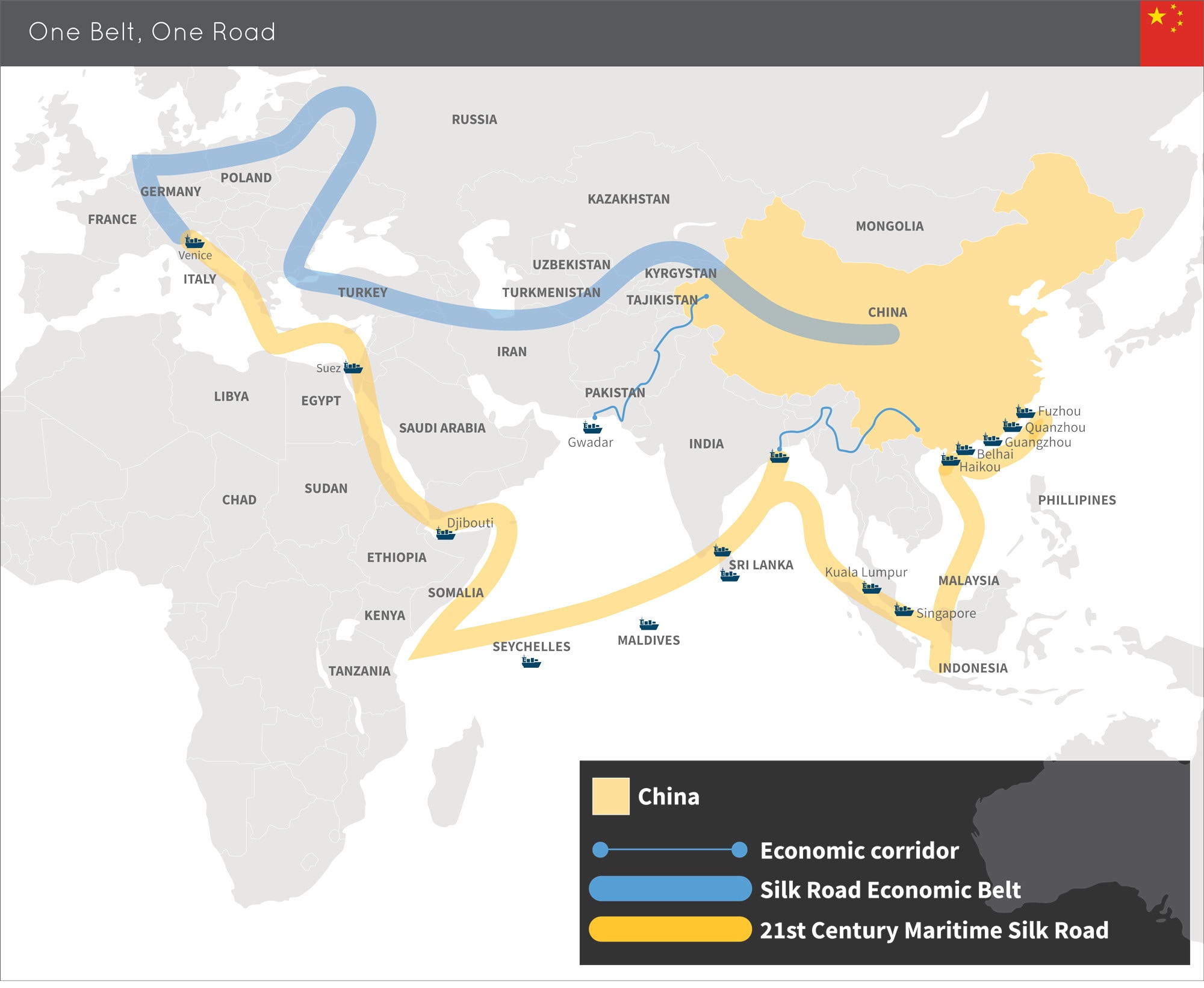


Income Inequality By Country 2021

The gap between the richest and the poorest has never been wider. In many countries, income inequality has increased as poverty also increases.
Income inequality has both economic and political impacts on a nation. These include political polarization, negative attitudes towards the wealthy, slower GDP growth, reduced income mobility, higher poverty rates, and greater household debt.
The Gini Coefficient
The Gini coefficient measures the distribution of incomes across income percentiles. The coefficient ranges from 0 (0%) to 1 (100%), with 0 representing perfect equality and 1 representing perfect inequality. For example, in a country where everyone has the same income, the Gini coefficient would be 0. However, if a single resident earned all of the income while everyone else earned nothing, the coefficient would be 1.
Mathematically, the Gini coefficient is defined based on the Lorenz curve. The Lorenz curve plots the percentiles of the population on the graph’s horizontal axis according to income or wealth, whichever is being measured. The cumulative income or wealth of the population is plotted on the vertical axis.
It is important to note that while the Gini coefficient is a useful tool for analyzing wealth or income distribution, it is not an absolute measurement of a country’s wealth. For example, high-income and low-income countries can have the same Gini coefficient. Additionally, the Gini coefficient may be inaccurate and overstate income inequality due to limitations such as a lack of reliable and up-to-date GDP and income information.
According to the most recent data, the following countries have the highest levels of income inequality:
- South Africa 62.7
- Namibia – 59.2
- Zambia – 58.1
- Mozambique – 53.9
- Botswana – 53.4
- Brazil – 53.1
- Angola – 51.3
- Colombia – 51
- Zimbabwe – 50.3
- Panama – 49.7
On the opposite end, the following countries have the least income inequality:
- Azerbaijan – 22.5
- Slovenia – 24.4
- Slovakia – 24.8
- Moldova – 24.8
- Czechia – 24.8
- Belarus – 25.1
- United Arab Emirates – 26
- Iceland – 26.4
- Urkaine – 26.7
- Belgium – 27.2
The United States’ Gini coefficient is .484, the highest it’s been in 50 yearsaccording to the U.S. Census Bureau. The U.S. has the highest Gini coefficient among the G7 nations. The top 1% of earners in the United States earn about 40 times more than the bottom 90% of earners. About 33 million U.S. workers earn less than $10 per hour, placing a family of four below the poverty line.
In the 1990s, the United Nations drafted “Agenda 21″
At the time, I remember reading that the American mainstream media was calling the New World Order a “conspiracy theory” and denied that any such thing existed. They pooh-poohed the idea of a One World Government, as well.
In 1992, however, in their Venezuela conference, the United Nations passed something called “Agenda 21,” which the elder President George Bush of the United States of America publicly gave it his support. It referred to something called “Sustainable Development” and seemed to be concerned with protecting the planet by limiting and controlling the development of corporate and personal structures SOURCE

spacer

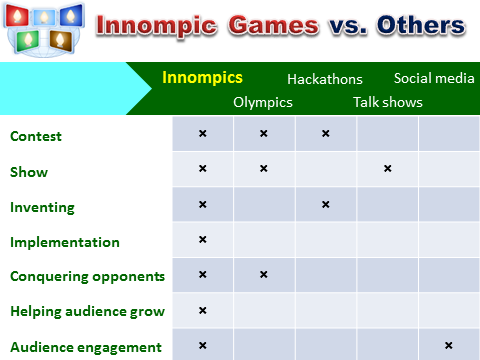

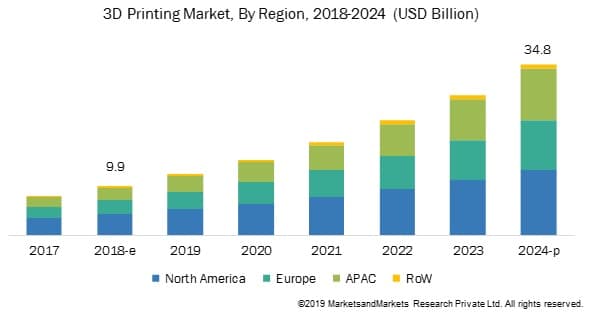













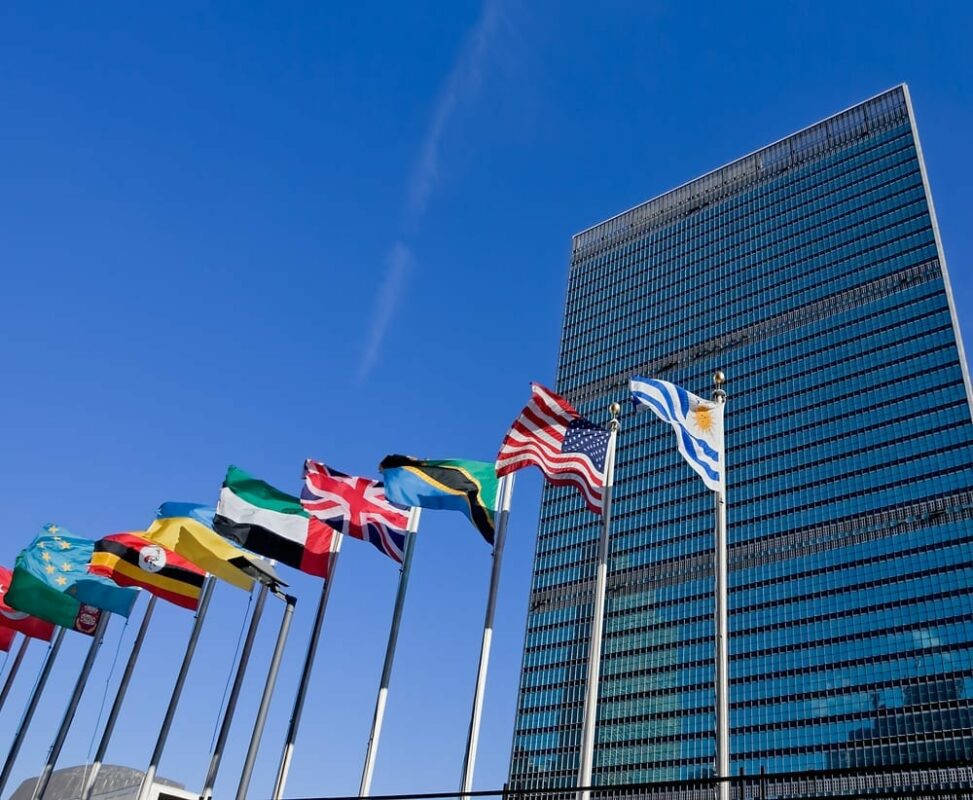

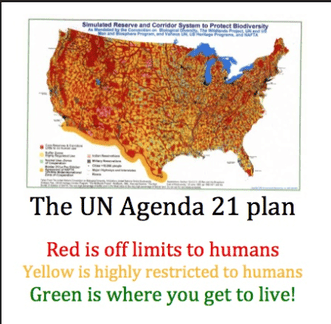

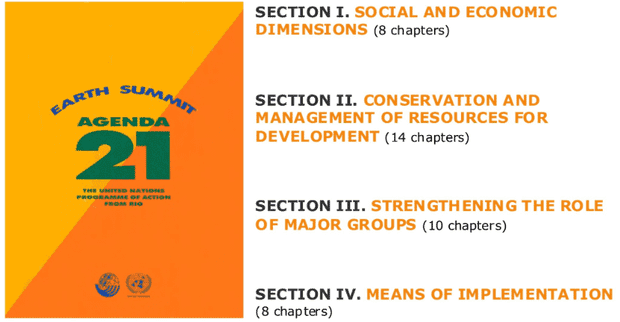
 Photo:
Photo: